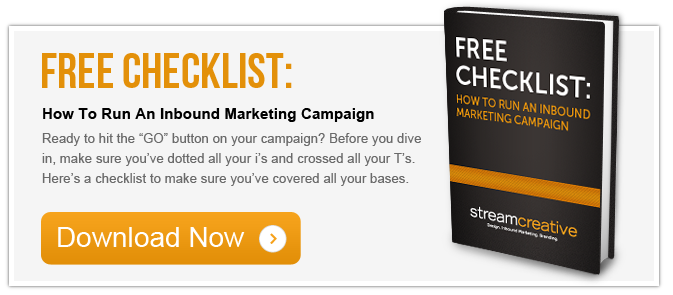
Day to day, situations present themselves that make human beings naturally skeptical. From weather reports to religious beliefs, aggressive work deadlines, or if a co-workers lunch is actually edible - skepticism represents the absence of knowing all the facts. Information is what converts a skeptic into a full believer.
Like any evangelist, inbound marketing professionals face circumstances where their philosophies and beliefs will be questioned. Thankfully, the foundation lies in the undeniable proof and statistics that show the impact inbound marketing can make for those who use it successfully. The challenge is effectively communicating facts and examples in a way that is adapted to best make an impact pertaining to the skeptic’s particular service or business. Frank the Tank (Will Ferrell) displays this style best.
If you tap into these 4 characteristics of how an individual’s brain works, you may just transform a skeptic into a believer.
1. Skeptics will listen as you establish trust.
For change and the investment made to be successful, we need to break down the natural wall that tends to be up when a new idea or solution is presented. Here are a few steps to help establish an initial level of trust:
Acknowledge that change and results will not happen overnight.
It probably took longer than a few days or weeks to realize that your current marketing strategies and tactics did not produce the results expected. Inbound marketing is no different and will take a time investment from your team to be implemented effectively.
Admit that change is not going to be easy and acknowledge the value of work that has been and will need to be put in place.
New ideas and strategies can be hard to accept because sometimes it means moving away from something that we have spent a great amount of time trying to build. In most situations, inbound marketing requires involvement from a variety of team members and a defined set of processes and goals. Spend some time arranging who should be involved. Establishing set responsibilities with the contributing team builds a higher level of accountability.
Walk the walk before you ask for trust.
It is hard to ask for trust when methodologies have not been personally proven. Take a few steps to put a few inbound marketing practices into place before trying to convert a skeptic into a believer. Create valuable content and make it available to help drive traffic to your website. Use social sites to link back to the valuable content created and interact with influencers who share your information. One of the best ways to walk the walk before establishing trust is to use a HubSpot trial to the fullest and report the real data that is acquired.
2. Skeptics will ask pointed questions.
Preparation is the key when making any pitch to sway someone’s opinion or motivate change. Anticipate and be prepared to answer questions that support your argument and position related to inbound marketing. These questions will likely come up at some point of the process…
How does inbound differ from traditional?
Outbound, or traditional marketing is about pushing a message out through certain channels to gain attention – which is often perceived as a disruptive method of building interest. Inbound marketing is about creating valuable content through blogging and premium content offers – most often viewed and downloaded specifically by the individuals (buyer personas) they were written for.
How do we know it's right for our business?
Inbound marketing focuses on positioning a company and its leadership / employees as experts in their industry or field. It is a strategy that allows departments and company representatives take ownership and contribute to the process. Through inbound’s relationship-based sales funnel process, it is a highly effective way to engrain a company’s culture into the life of their target buyer persona(s).
How does it give us a competitive advantage?
The internet is the easiest place for a business to build market share. A website that has strong content, link-backs and continues to publish relevant content on a regular basis will establish stronger authority with search engines, including Google. Web traffic, organic keyword ranking, and social media connections do not have to be purchased – they can be earned.
3. Skeptics will need reliable resources & facts to buy–in to the information presented.
Inbound has proven to be more effective than outbound marketing at both generating leads and driving sales. This statement alone will not convert a skeptic into a believer, but here are a few facts that will (courtesy of Impulse Creative).
An inbound lead costs 61% less than an outbound lead.
Inbound marketing doesn’t just cost less to generate leads; it drives more qualified leads that fall within your target buyer persona.
Companies that blog once a month generate 70% more leads.
The great part about this fact is that it is not time consuming to generate a small amount of content, which at the very least will produce more traffic to your site. With a little more effort and contribution from your team and partners, leads increase dramatically.
70% of all links clicked are from organic, not paid.
Creating valuable content can be the most effective way to drive potential customers to your site. Optimizing content with keywords will help you dominate an organic search.
4. Skeptics will look for the bottom line.
Setting realistic expectations with a skeptic is critical. It can take at least six months to start seeing sales from leads and website traffic. It takes many companies a year to see a full ROI. It comes down to team contribution, understanding buyer personas and the challenges with each, and the intensity of your team’s approach. Ways to see impact to the bottom line quickly include:
Incorporate inbound tactics into outbound methods of outreach.
When sending an email distribution, instead of providing a “free _____”, include a top of the sales funnel offer, e-book or white paper. When placing print ads, include lead generating content and a trackable URL. If your company attends trade shows, prepare a lead nurturing campaign ahead of time with valuable information.
Add visual calls-to-action on your website.
Calls-to-action (CTAs) are important components to your website in regard to generating leads. Placing a CTA in every spot on your website that a new visitor may see is critical to capturing important information that will begin nurturing the prospect through the sales funnel. Since a blog post may be found through an organic search, it is one of the most important areas to include a CTA.
Share valuable content that targets your buyer personas.
Understanding your buyer personas is one of the most important factors to creating valuable content. Visitors are likely to have further engagement with a business and trust for your brand if they’ve gained something from your content. Factors to consider when generating content include aiming to solve a prospects problem, elicit an emotion or empathize with their needs.
Track and analyze your activities so you know what is and is not working.
Marketing professionals report spending 8% of their budgets on marketing analytics and expect to increase this level in the next three years (Source: CMO Survey). Along with Google Analytics, many social media platforms or scheduling tools offer analytics reporting functions; however HubSpot offers easy to use and robust tools and reports to analyze inbound marketing tactics. One way to immediately evaluate success is by reviewing growth in organic traffic and leads. Additionally, looking at social engagement rather than just reach can be a way to review the value visitors or readers are placing on the content provided.
When done right, the statistics that support inbound marketing and the impact it can make on generating leads for your business will turn any skeptic into a believer. Being prepared with the facts, examples and immediate actions your business can take will only strengthen your reasoning for change. Consider each team member's role in the process, their unique expertise and how they contribute. This is a great example of teamwork leveraging individual strengths...just be sure nobody starts on fire.
What challenges have you faced in your place of business or among your department to convert inbound skeptics to believers?






